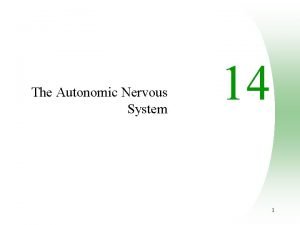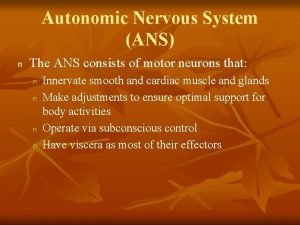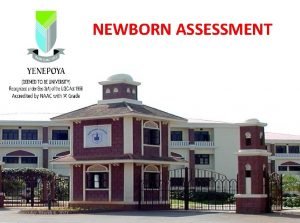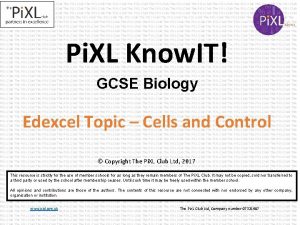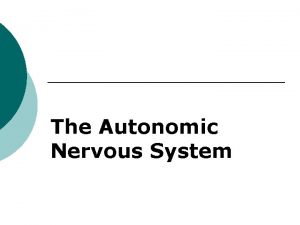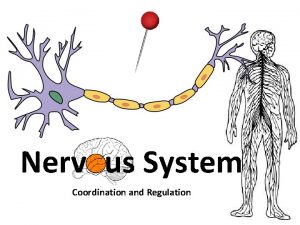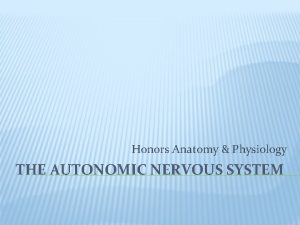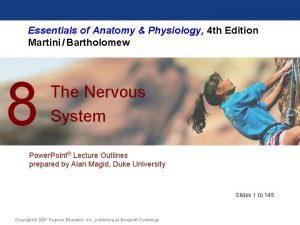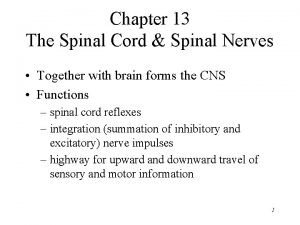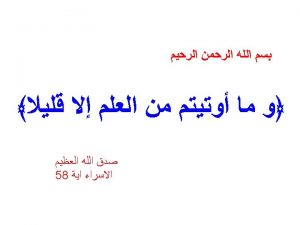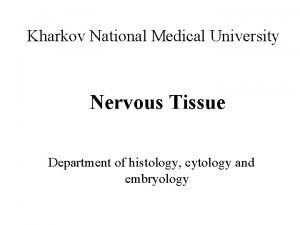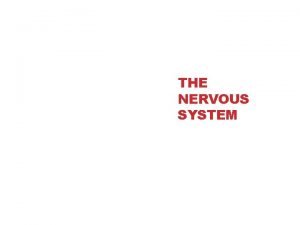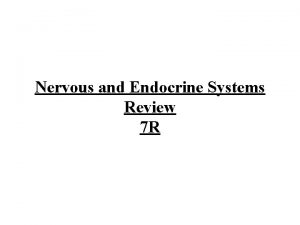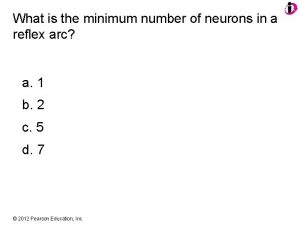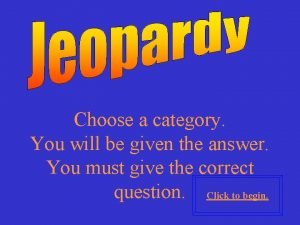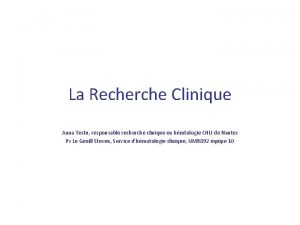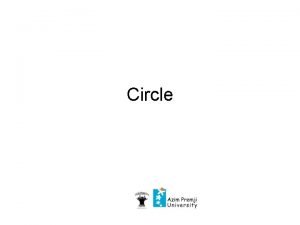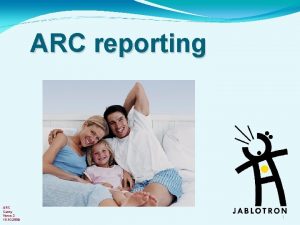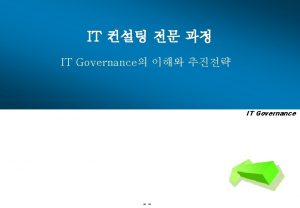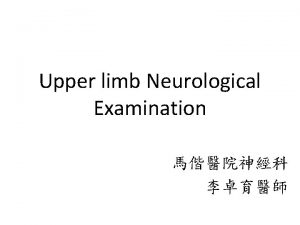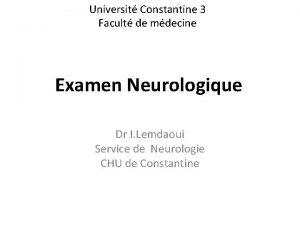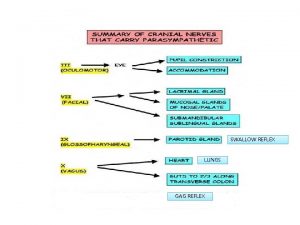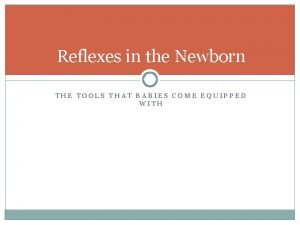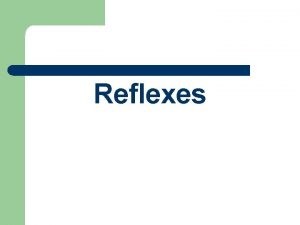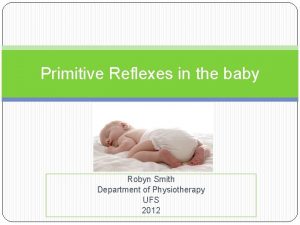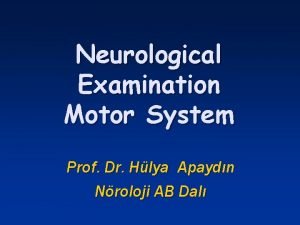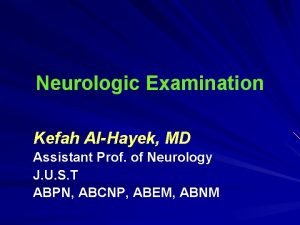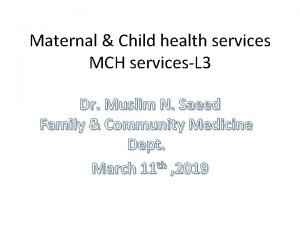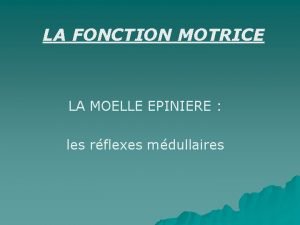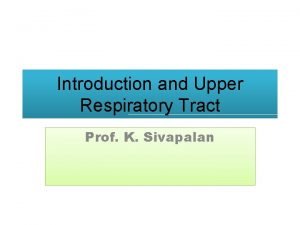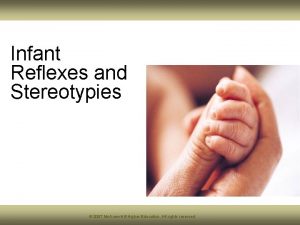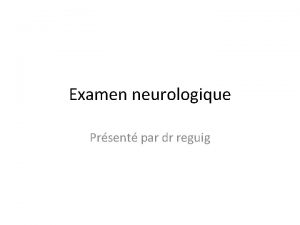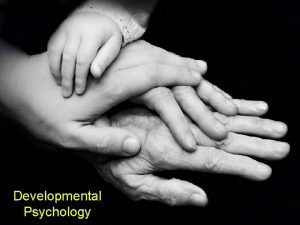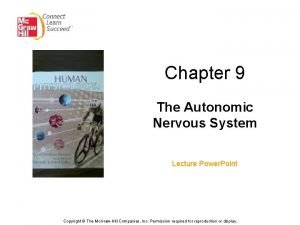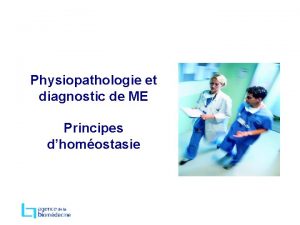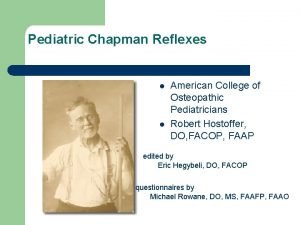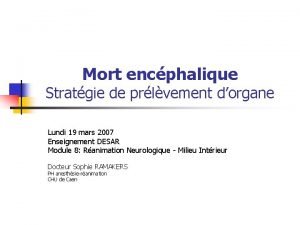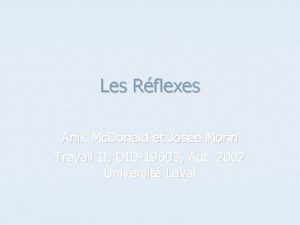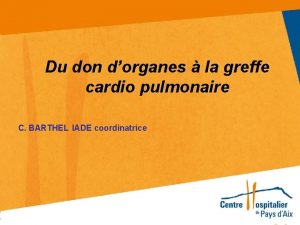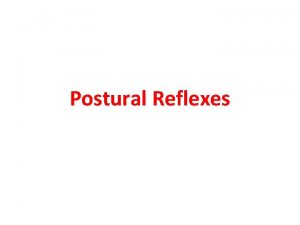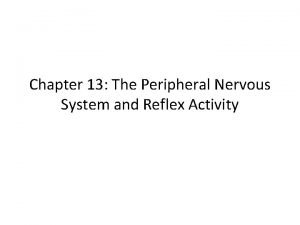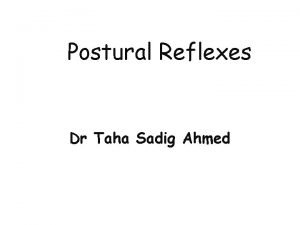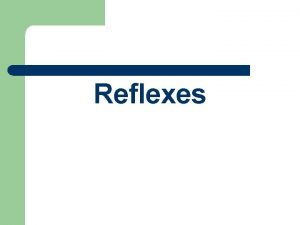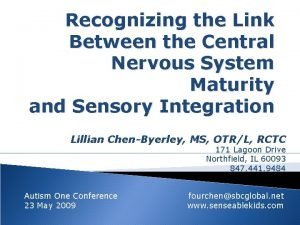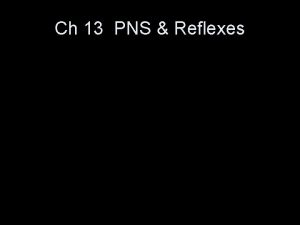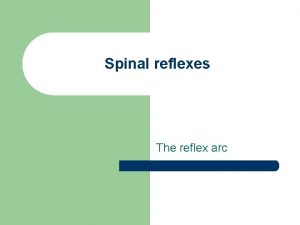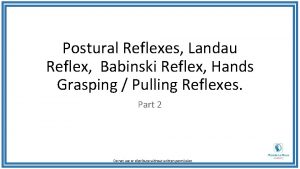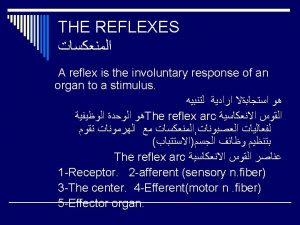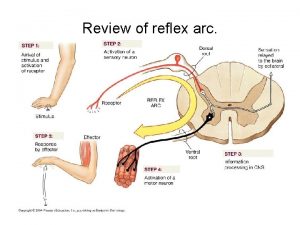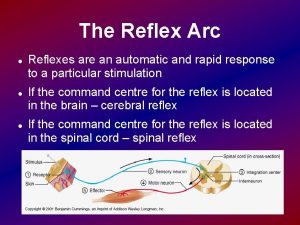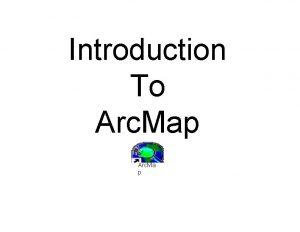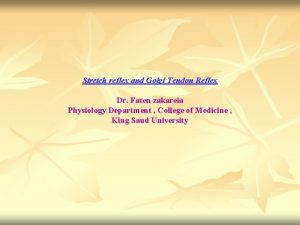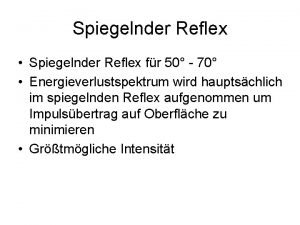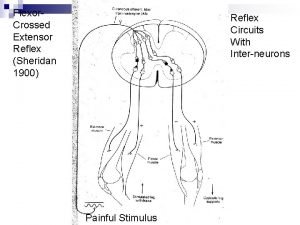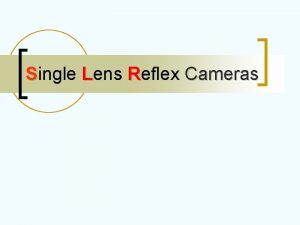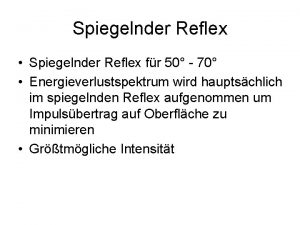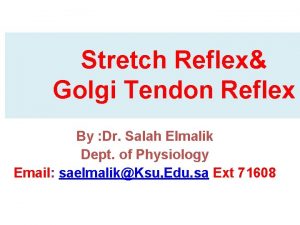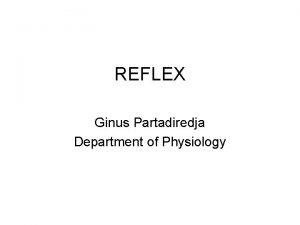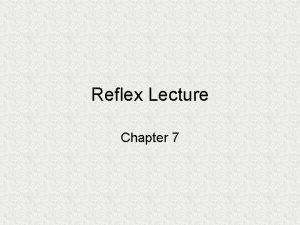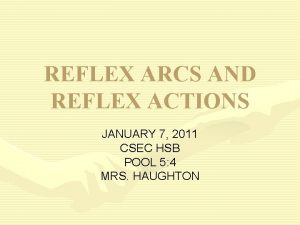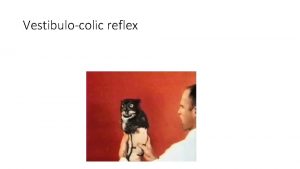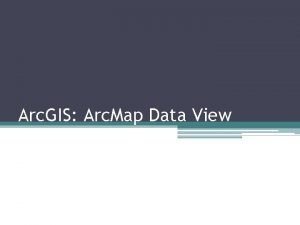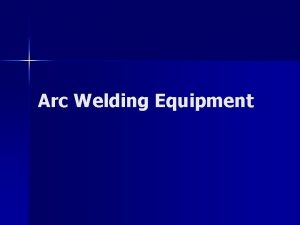Reflexes present in infants Contents Introduction Reflex arc




















































- Slides: 52

Reflexes present in infants

Contents • • • Introduction Reflex arc Classification of reflexes Significance of reflexes Types of reflexes • Conclusion

Introduction • A reflex is an involuntary or automatic action that your body does in response to something without even having to think about it • Neonatal reflexes – inborn reflexes present at birth & occur in a predictable fashion • Normally developing newborn should respond to certain stimuli with these reflexes

Reflex arc • Anatomical pathway for a reflex is called as reflex arc • A reflex arc is the pathway followed by nerves which (a. ) carry sensory information from the receptor to the spinal cord, and then (b) carry the response generated by the spinal cord to effector organ(s) during a reflex action. • Ø Ø Ø It has 5 components : Receptor Afferent nerve Center Efferent nerve Effector organ

• Somatic receptors in the skin, muscles and tendons. • Afferent nerve fibers carry signals from the somatic receptors to the posterior horn of the spinal cord or to the brainstem • An integrating center, the point at which the neurons that compose the gray matter of the spinal cord or brainstem synapse • Efferent nerve fibers carry motor nerve signals to muscles • Effector muscle innervated by the efferent nerve fiber carries out the response.

Classification of reflexes • Depending upon whether inborn or acquired Ø Unconditioned reflexes, inborn reflex Ø Conditioned reflexes/acquired reflexes

• Depending upon the situation of the center Ø Ø Ø Cerebellar reflexes Cortical reflex Midbrain reflex Bulbar or medullary reflexes Spinal reflexes

• Depending upon the purpose Ø Protective/flexor reflexes Ø Antigravity/extensor reflexes § Ø ü ü Ø Ø Ø Depending upon clinical basis Superficial reflexes Mucus membrane Cutaneous reflex Deep reflexes Visceral reflexes Pathological reflexes

Significance of reflexes • Helps a paedodontist to identify whether the child is developing normally or not • Tells about what abnormalities the child may be having if all reflexes are not proper • Knowledge of development of motor skills – helps to identify whether development is going on at a proper rate or not

Types of reflexes

Ø General body reflexes : ü ü ü Moro reflex/Startle reflex Palmar/grasp reflex Plantar grasp reflex Walking/stepping reflex Limb placement reflex Asymmetric tonic neck reflex Symmetric tonic neck reflex Babinski’s reflex Babkin reflex Parachute reflex Landau reflex

ü Withdrawal reflex ü Trunk incurvation reflex ü Tendon reflexes ü Gallant’s reflex ü Tonic labyrinthine reflex Ø Facial reflexes : ü ü Nasal reflex Blink reflex Doll’s eye reflex Auditory orienting reflex

Ø Oral reflexes : ü ü ü Rooting reflex Sucking reflex Swallowing reflex Gag reflex Cry reflex

General body reflexes • Moro reflex/ startle reflex Ø Begins at 28 weeks of gestation Ø Initiated by any sudden movement of the neck Ø Elicited by -- pulling the baby halfway to sitting position from supine & suddenly let the head fall back Ø Consists of rapid abduction & extension of arms with the opening of hands, tensing of the back muscles, flexion of the legs and crying

Ø Within moments, the arms come together again • Clinical significance Ø Its nature gives an indication of muscle tone Ø Failure of the arms to move freely or the hands to open fully indicates hypotonia. Ø It fades rapidly and is not normally elicited after 6 months of age.

• Palmar/grasp reflex Ø Begins at 32 weeks of gestation Ø Light touch of the palm produces reflexion of the fingers Ø Most effective way -- slide the stimulating object, such as a finger or pencil, across the palm from the lateral border Ø Disappears at 3 -4 months Ø Replaced by voluntary grasp at 45 months

• Clinical significance Ø Exceptionally strong grasp reflex -- spastic form of cerebral palsy & Kernicterus Ø May be asymmetrical in hemiplagia & in cases of cerebral damage Ø Persistence beyond 3 -4 months indicate spastic form of palsy

• Plantar/grasp reflex Ø Placing object or finger beneath the toes causes curling of toes around the object Ø Present at 32 weeks of gestation Ø Disappears at 9 -12 months • Clinical significance : Ø This reflex is referred to as the "readiness tester". Ø Integrates at the same time that independent gait first becomes possible.

• Walking/stepping reflex Ø When sole of foot is pressed against the couch, baby tries to walk Ø Legs prance up & down as if baby is walking or dancing Ø Present at birth, disappears at approx 2 -4 months Ø With daily practice of reflex, infants may walk alone at 10 months

Clinical significance Ø Premature infants will tend to walk in a toe-heel fashion while more mature infants will walk in a heeltoe pattern.

• Limb placement reflex Ø When the front of the leg below the knee or the arm below the elbow is brought into contact with the edge of a table, child lifts the limbs over the edge Ø Present at birth, fades away rapidly in early months of life • Clinical significance Ø Reflex is readily demonstrable in the newborn and persistent failure to elicit it at this stage, is thought to indicate neurological abnormality

• Withdrawal reflex Ø Protective reflex Ø Stimulus : a pinprick or a sharp painful stimulus to sole of foot Ø Response : flexion & withdrawal of stimulated leg Ø Present at birth, persists throughout life Ø Clinical significance – Absence of this is seen in neurologically impaired infants.

• Asymmetric tonic neck reflex Ø Most evident between 2 -3 months of age Ø When the face of the child is turned to one side, the arm and leg on the side to which the face is turned extend and the arm and leg of the opposite side flex. • Clinical significance Ø The reflex fades rapidly and is not normally seen after 6 months of age. Ø Persistence is the most frequently observed abnormality of the infantile reflexes in infants with neurological lesions Ø Greatly disrupts development

• Symmetric tonic neck reflex Ø Extension of the head causes extension of the fore limbs and flexion of the hind limbs Ø Evident between 6 -7 months of age and dissapears by 2 -3 years. Ø Clinical significance ü Not normally easily seen or elicited in normal infants ü May be seen in an exaggerated form in many children with cerebral palsy.

• Babinski’s reflex Ø Stimulus consists of a firm painful stroke along the lateral border of the sole from heel to toe Ø Response consists of movement (flexion or extension) of the big toe and sometimes movement (fanning) of the other toes Ø Present at birth, disappears at approx 9 -10 months Ø Presence of reflex later may indicate disease

• Babkin reflex Ø Deep pressure applied simultaneously to the palms of both hands while the infant is in supine position Ø Stimulus is followed by flexion or forward bowing of the head, opening of the mouth and closing of the eyes Ø Fades rapidly and normally cannot be elicited after 4 months of age.

• Clinical significance Ø Reflex can be demonstrated in the newborn, thus showing a hand-mouth neurological link, even at that early stage

• Parachute reflex Ø Reflex appears at about 6 -9 months & persists thereafter Ø Elicited by holding the child in ventral suspension & suddenly lowering him to the couch Ø Arms extend as a defensive reaction • Clinical significance Ø Absent or abnormal in children with cerebral palsy Ø Would be asymmetrical in spastic hemiplagia

• Landau reflex Ø A normal response Seen in horizontal prone position – a convex arc with the head raised and the legs slightly flexed. Ø Appears at approximately 3 months, disappears at 12 -24 months • Clinical significance Ø Absence of reflex occurs in hypotonia, hypertonia or mental abnormality

• Trunk incurvation reflex Ø Stroking one side of spinal column while baby is on his abdomen causes ü Crawling motion with legs ü Lifting head from surface Ø Present in utero, seen at approximately 3 rd or 4 th day Ø Persists for 2 -3 months

• Gallant’s reflex Ø Firm sharp stimulation along sides of the spine with the fingernails or a pin produces contraction of the underlying muscles and curving of the back. Ø Response is easily seen when the infant is held upright and the trunk movement is unrestricted Ø Best seen in the neonatal period and thereafter gradually fades.

• Tendon reflexes Ø Simple monosynaptic reflexes, which are elicited by a sudden stretch of a muscle tendon Ø Occurs when the tendon is tapped Ø Present throughout life

Spinal cord levels of the tendon reflexes

• Clinical significance Ø Useful diagnostically for : ü Detection of upper motor neuron lesions (exaggerated response) ü Myopathic conditions (depressed or absent response) ü Localization of the segmental lesions of the cord.

• Tonic labyrinthine reflex Ø Labyrinths – complex structure in the ear contains organs for hearing and balance. Ø Movement of the head in any dimension stimulates the labyrinths; and produces the appropriate responses Ø Arms & legs extend when head moves backwards, & will curl in when the head moves forward Ø Emerges in utero until approximately 4 months postnatally

Facial reflexes • Nasal reflex Ø Stimulation of the face or nasal cavity with water or local irritants produces apnea in neonates Ø Breathing stops in expiration with laryngeal closure in infants – bradycardia & lowering of cardiac output Ø Blood flow to skin, splanchnic areas muscles (visceral )& kidney decreases Ø Flow to the heart & brain remains protected

• Blink reflex Ø A bright light suddenly shone into the eyes, a puff of air upon the sensitive cornea or a sudden loud noise will produce immediate blinking of the eyes Ø Purpose – to protect the eyes from foreign bodies & bright light Ø May be associated tensing of the neck muscles, turning of the head away from the stimulus, frowning and crying Ø Reflexes are easily seen in the neonate and continue to be present throughout life

• Clinical significance Ø Examination is a part of some neurological exams, particularly when evaluating coma Ø Satisfactory demonstration of these reflexes indicate – ü No cerebral depression ü Contraction of appropriate muscles in response

• Doll’s eye reflex (Oculocephalic reflex) Ø Passive turning of the head of the Head newborn leaves the eye “behind” Eye Ø A distinct time lag occurs before the eyes move to a new position in keeping with the head position Ø Disappears at within a week or two of birth Ø Failure of this reflex to appear indicates a cerebral lesion

• Auditory orienting reflex Ø A sudden loud and unpleasant noise : ü May produce the blink reflex ü Infant may remain still and show increased alertness Ø Quieter sounds usually cause reflex eye and head turning to the side of the sound, as if to locate it Ø Seen first at about 4 months of age Ø Thereafter, head turning towards sound stimuli occurs and the accuracy of localization increases rapidly by 9 -10 months

• Clinical significance Ø Reflex responses are made use of in tests of infants for hearing loss Ø Pattern of the localization responses indicates the level of neurological maturity

Oral reflexes • Rooting reflex Ø Baby’s cheek is stroked : ü They respond by turning their head towards the stimulus ü They start sucking, thus allowing for breast feeding Ø When corner of mouth is touched, lower lip is lowered, tongue moves towards the point stimulated Ø When finger slides away, head turns to follow it Ø When center of lip is stimulated, lip elevates

• Onset -- 28 weeks IU • Well established – 32 -34 weeks IU • Disappears – 3 -4 months • Clinical significance Ø Persistence can interfere with sucking Ø Absence of this is seen in neurologically impaired infants.

• Sucking / Swallowing reflex Ø Touching lips or placing something in baby’s mouth causes baby to draw liquid into mouth by creating vacuum with lips, cheeks & tongue Ø Onset – 28 weeks IU Ø Well established – 32 -34 weeks IU Ø Disappears around 12 months

• Clinical significance : Ø Persistence may inhibit voluntary sucking Ø Sigmund Freud - Any kind of deprivation of the activity will lead to fixation resulting in oral habits

• Gag reflex (Pharyngeal reflex) Ø Seen in 19 weeks of IU life Ø Reflex contraction of the back of the throat Ø Evoked by touching the roof of the mouth, the back of the tongue, the area around the tonsils and the back of the throat

• Functional significance Ø It, along with reflexive pharyngeal swallowing, prevents something from entering the throat except as part of normal swallowing and helps prevent choking § Clinical significance Ø Absence of the gag reflex -- symptom of a number of severe medical conditions : ü Damage to the glossopharyngeal nerve, the vagus nerve, ü Brain death.

• Cry reflex Ø Non conditioned reflex which accounts for its lack of its individual character Ø Sporadic in nature Ø Starts as early as 21 -29 weeks of IU life

• Importance of cry Ø It is infant’s first verbal communication Ø Can be interpreted as a message of urgency or distress Ø ü ü ü Indicates: Hunger Pain Discomfort

Conclusion Appropriate knowledge of reflexes enables a paedodontist Ø to identify whether the child is developing normally or not Ø to identify whether development is going on at a proper rate or not Ø Knowledge of abnormalities if all reflexes are not proper


References • Shobha Tandon. Textbook of Paedodontics • MS Muthu. Paediatric Dentistry, Principals & practice
 Somatic reflex vs visceral reflex
Somatic reflex vs visceral reflex Ans
Ans Parachute reflex
Parachute reflex Structure of the reflex arc
Structure of the reflex arc Ans hypothalamus
Ans hypothalamus Spinal cord diagram
Spinal cord diagram Edrolo
Edrolo Ans
Ans Pearson
Pearson Structure of the reflex arc
Structure of the reflex arc Spinal nerves names
Spinal nerves names Slidetodoc. com
Slidetodoc. com Reflex
Reflex Type of reflex arc
Type of reflex arc Cerebrospinal fluid (csf)
Cerebrospinal fluid (csf) Reflex arc diagram labeled
Reflex arc diagram labeled What is the minimum number of neurons in a reflex arc?
What is the minimum number of neurons in a reflex arc? 234
234 自律神經 wiki
自律神經 wiki What is the correct sequence in a typical reflex arc
What is the correct sequence in a typical reflex arc Arc promoteur vs arc investigateur
Arc promoteur vs arc investigateur Minor segment of a circle
Minor segment of a circle What is minor arc?
What is minor arc? Arc emu88 com arc info 45 100045 html
Arc emu88 com arc info 45 100045 html Contents introduction
Contents introduction Muscle tone grading scale
Muscle tone grading scale Force musculaire cotation
Force musculaire cotation Gag swallow reflexes
Gag swallow reflexes Baby reflexes
Baby reflexes Supinator jerk
Supinator jerk Gallant's reflex
Gallant's reflex Pronator drift sign
Pronator drift sign Muscle strength grading 1-5
Muscle strength grading 1-5 Primitive reflexes chart
Primitive reflexes chart Infant reflexes chart
Infant reflexes chart Les reflexes osteo tendineux
Les reflexes osteo tendineux Protective reflexes
Protective reflexes Infant reflexes chart
Infant reflexes chart Testing moteur
Testing moteur Grasping reflex psychology
Grasping reflex psychology Terminal ganglia
Terminal ganglia Reflexes du tronc
Reflexes du tronc Anterior chapman points
Anterior chapman points Reflexes du tronc
Reflexes du tronc Reflexes du tronc
Reflexes du tronc Reflexes du tronc
Reflexes du tronc Statokinetic reflex examples
Statokinetic reflex examples Muscle spindle
Muscle spindle Decerebrate posturing
Decerebrate posturing Art-labeling activity: main nerves of the brachial plexus
Art-labeling activity: main nerves of the brachial plexus Superficial reflexes
Superficial reflexes Labyrinthine reflexes
Labyrinthine reflexes Brain stem reflexes ppt
Brain stem reflexes ppt
